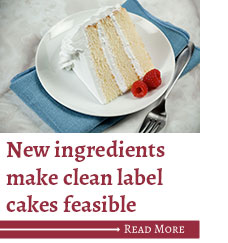Clean label has been an opportunity for indulgent cakes in a health-obsessed food environment, but it’s also been a challenge because of issues of lost functionality and product quality.
“Traditionally, consumers had to pick between moist, decadent cakes and applications with simplified ingredients because bakers could not achieve the same functionality when using clean label solutions,” said Ashley Robertson, market manager, bakery, Corbion.
A successful cake batter can be broken down in a few ways. It’s a balance of tougheners and tenderizers. Tougheners like flour, milk solids, egg whites and salt give cakes their structure. Tenderizers — sugar, fat and egg yolks — keep things moist, one of the most desirable characteristics of a finished cake. A cake that consumers will eat cannot have one without the other.
Cake batter also can be understood as a complex oil-in-water emulsification. This helps attain another important aspect of cake batter: aeration. Proper aeration is essential to leavening. It contributes to the crumb moisture and the tenderness of the bite. Air entrapment is a delicate process, one that is affected on a molecular level and has repercussions in the final texture of the cake. Emulsifiers and shortening allow bakers to achieve the aeration they need for the desired crumb, moistness and cake volume.

The delicacy of cake batter means there isn’t much room for error. Change must be handled with care.
“When it comes to simplifying ingredients in sweet baked goods like cakes, even minor formulation changes can affect taste, texture and freshness,” Ms. Robertson said.
Those changes toward simpler labels have not always been easy on the cake industry. Bakers are replacing artificial flavors, colors and preservatives as well as partially hydrogenated oils. Additives like sodium stearoyl lactylate and chlorinated/bleached flour ingredients like DATEM and polysorbates don’t stand a chance with the label-conscious consumer.
These ingredients, however, contribute to batter stability and aeration, volume, texture, moisture and freshness.
“For example, DATEM is typically used to create a strong gluten structure in the batter while polysorbates can be used to enhance shelf life and texture of popular snack cakes,” Ms. Robertson explained.
Collaboration between bakers and ingredient suppliers have resulted in some innovation breakthroughs. Formulators have honed in on what consumers actually want from ingredient lists and finished product, and that has resulted in more functional ingredients.
“Suppliers are offering new alternatives to help shorten the ingredient list and replace undesirable ingredients,” said Sarah Mann, senior application technologist, bakery, DuPont Nutrition & Health. “Although some alternatives may not fully replace the functionality of certain key ingredients, there are more options available now than there were just a few years ago.”
Defining clean label
Understanding what clean label actually means to bakers — and their consumers — has been an important step in successful reformulation of cake batters.
“Getting a clear definition of what is considered clean label can be a challenge when it comes to cakes and sweet goods,” said Jeff Nelson, western vice-president of sales, Brolite Products. “It seems there are many different definitions of clean label and what exactly can or cannot be on a clean label.”
This definition can be unique to each baker, retailer and consumer.
“Research indicates consumers prefer a shorter ingredient list, less chemically sounding ingredients, fewer artificial ingredients and minimally processed foods,” Ms. Mann explained. “So consumers prefer a much more simple and understandable ingredient list.”
According to Ingredion’s proprietary research conducted by MMR Research Associates, the clean label trend can be marked by two themes: simplicity and healthy halo. Simplicity refers to fewer and more familiar ingredients, and healthy halo supports nutrition expectations. According to the study of 309 U.S. consumers, 79% of respondents said it is important that they recognize all ingredients on food and drink packaging. The same percentage considered a short and simple ingredient to be important.
And while there is no official definition of what makes an ingredient list clean, the research suggests three criteria are most critical to cleaning up the label. No artificial ingredients, removal of perceived negative ingredients, and organic were all ranked as the most important by manufacturers regarding their clean label products. Consumers’ top three health claims, according to Ingredion’s research, were natural, no artificial ingredients and no additives.
Regardless of its flexible definition, clean label has staying power as a trend, which has led bakers to reformulate. According to the findings in Ingredion’s study, 69% of manufacturers have reformulated for clean label during the past two years, and 81% expect to do so over the next two years. Seventy-three percent believe clean label is here to stay.
Equipped with this information, product developers can work with suppliers to pinpoint what ingredients they’d like to replace in their cake batter formulations.
Together at the drawing board
After defining what clean label means, the next hurdle will be reformulation. For a category such as cakes, it takes a collaborative effort between baker and ingredient supplier.
“The other major challenge is the ability to remove these particular ingredients and replace them with ingredients that still give the same functionality, quality and shelf life consumers prefer,” Ms. Mann said. “It is important to identify the challenges bakers are facing in our initial conversations. Then we can work with bakers to provide a solution that is specific to their needs.”
Despite progress that’s been made, Peggy Dantuma, director, technical sales, bakery, Kerry Ingredients, said there is still much work to be done. Striking this balance of label demands and finished product quality requires revisiting every ingredient’s role.
 “This usually means re-engineering the entire formula as there are not currently drop-in solutions for these traditional ingredients,” she said. “Kerry assists bakers by educating them on the functionality of the various ingredients and then evaluating ways to minimize the negative ingredients while maintaining product quality.”
“This usually means re-engineering the entire formula as there are not currently drop-in solutions for these traditional ingredients,” she said. “Kerry assists bakers by educating them on the functionality of the various ingredients and then evaluating ways to minimize the negative ingredients while maintaining product quality.”
Understanding how the ingredients function means starting with the specific application. Cake formulations, for the most part, use a similar roster of ingredients: flour, sugar, eggs, shortening, dry milk solids, salt and leaveners. Starches and emulsifiers play important roles, too. But from pound cake to angel food, the specific ingredients and their ratios change to create the finished texture and eating characteristics that mark that application.
“It’s important to consider the type of cake such as angel food, Bundt and sponge, as well as the desired quality and consistency of the product when making the switch to cleaner labels,” Ms. Robertson said.
Corbion works alongside bakers to find a system that meets both the specific application’s needs as well as those of the consumer.
“For example, if a baker is looking to remove ingredients that traditionally help with product softness and moistness, we take steps to ensure the clean label solution we recommend delivers the same functionalities, which in turn helps maintain product taste and quality,” Ms. Robertson explained.
Throughout the reformulating process, Corbion conducts taste tests to make sure the final product will not fall short of consumer expectations of taste, texture or consistency.
“If necessary, we go back to the drawing board and modify solutions to match the characteristics that are most important to each baker’s brand and specific applications or consumer preferences,” she said.
By collaborating with ingredient suppliers and incorporating the latest in clean label ingredients, cake bakers can re-tool their formulations to create a functional quality product with a cleaner label.




